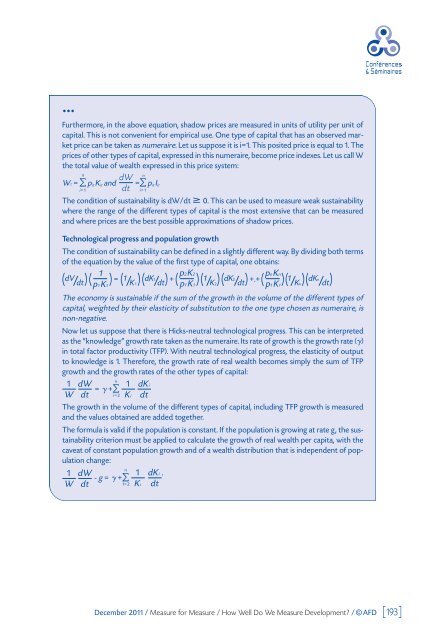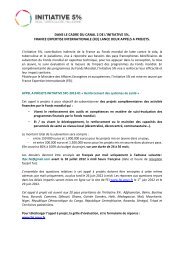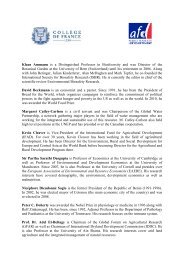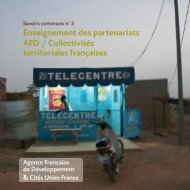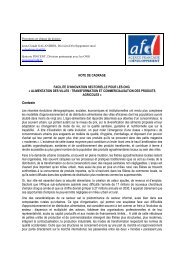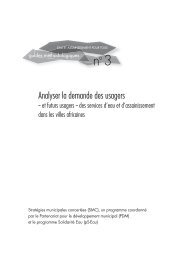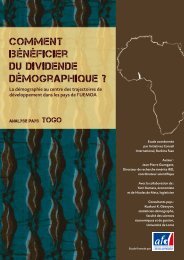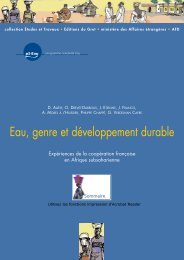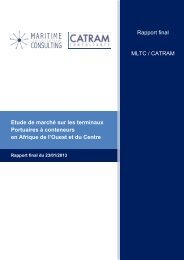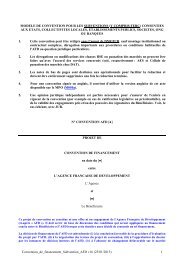Paris School of Economics - L'Agence Française de Développement
Paris School of Economics - L'Agence Française de Développement
Paris School of Economics - L'Agence Française de Développement
Create successful ePaper yourself
Turn your PDF publications into a flip-book with our unique Google optimized e-Paper software.
Furthermore, in the above equation, shadow prices are measured in units <strong>of</strong> utility per unit <strong>of</strong><br />
capital. This is not convenient for empirical use. One type <strong>of</strong> capital that has an observed market<br />
price can be taken as numeraire. Let us suppose it is i=1. This posited price is equal to 1. The<br />
prices <strong>of</strong> other types <strong>of</strong> capital, expressed in this numeraire, become price in<strong>de</strong>xes. Let us call W<br />
the total value <strong>of</strong> wealth expressed in this price system:<br />
n<br />
n dW<br />
Wt = �� pit Kit and =�� pit Iit<br />
i =1<br />
dt i = 1<br />
The condition <strong>of</strong> sustainability is dW/dt �� 0. This can be used to measure weak sustainability<br />
where the range <strong>of</strong> the different types <strong>of</strong> capital is the most extensive that can be measured<br />
and where prices are the best possible approximations <strong>of</strong> shadow prices.<br />
Technological progress and population growth<br />
The condition <strong>of</strong> sustainability can be <strong>de</strong>fined in a slightly different way. By dividing both terms<br />
<strong>of</strong> the equation by the value <strong>of</strong> the first type <strong>of</strong> capital, one obtains:<br />
1<br />
p2 K2<br />
pn Kn<br />
( dV /dt ) ( ) = ( 1 /K 1 ) ( dK1/dt ) + ( ) ( 1 /K 2) ( dK2/dt ) +.+ ( ) ( 1 /Kn ) ( dKn/dt p1 K1<br />
p1 K1<br />
p1 K1<br />
)<br />
The economy is sustainable if the sum <strong>of</strong> the growth in the volume <strong>of</strong> the different types <strong>of</strong><br />
capital, weighted by their elasticity <strong>of</strong> substitution to the one type chosen as numeraire, is<br />
non-negative.<br />
Now let us suppose that there is Hicks-neutral technological progress. This can be interpreted<br />
as the “knowledge” growth rate taken as the numeraire. Its rate <strong>of</strong> growth is the growth rate (�)<br />
in total factor productivity (TFP). With neutral technological progress, the elasticity <strong>of</strong> output<br />
to knowledge is 1. Therefore, the growth rate <strong>of</strong> real wealth becomes simply the sum <strong>of</strong> TFP<br />
growth and the growth rates <strong>of</strong> the other types <strong>of</strong> capital:<br />
n<br />
1 dW<br />
1 dK i<br />
= � +��<br />
W dt<br />
i = 2 K i dt<br />
The growth in the volume <strong>of</strong> the different types <strong>of</strong> capital, including TFP growth is measured<br />
and the values obtained are ad<strong>de</strong>d together.<br />
The formula is valid if the population is constant. If the population is growing at rate g, the sustainability<br />
criterion must be applied to calculate the growth <strong>of</strong> real wealth per capita, with the<br />
caveat <strong>of</strong> constant population growth and <strong>of</strong> a wealth distribution that is in<strong>de</strong>pen<strong>de</strong>nt <strong>of</strong> population<br />
change:<br />
1<br />
W<br />
dW<br />
dt<br />
n<br />
- g = � +��<br />
1= 2<br />
1<br />
K i<br />
dK i .<br />
dt<br />
December 2011 / Measure for Measure / How Well Do We Measure Development? / © AFD [ 193]


